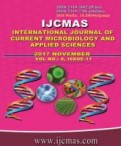


 National Academy of Agricultural Sciences (NAAS)
National Academy of Agricultural Sciences (NAAS)

|
PRINT ISSN : 2319-7692
Online ISSN : 2319-7706 Issues : 12 per year Publisher : Excellent Publishers Email : editorijcmas@gmail.com / submit@ijcmas.com Editor-in-chief: Dr.M.Prakash Index Copernicus ICV 2018: 95.39 NAAS RATING 2020: 5.38 |
A field experiment was conducted during rabi season of 2014-15 and 2015-16 with an objective to find out the effect of weed control treatments on crop & associated weeds and to determine a competitive understanding of the effect of various nitrogen management practices on productivity of wheat crop. The experiment was laid out in Split plot design with 16 treatment combinations viz. F1:RDN (120 Kgha-1), F2:25% N FYM+75% N through chemical fertilizer, F3:50% N FYM+50% N through chemical fertilizer, F4:75% N FYM+25% N through chemical fertilizer under nitrogen management practices in main plot and W0:Weedy check, W1:Weed free, W2:VESTA (Clodinafop 15% + metsulfuron methyl 1%), W3:TOTAL (Sulfosulfuron 75% + metsulfuron methyl 5%) under weed management treatments in sub plot with three replications. Nitrogen management practices affects significantly with treatment F1: RDN (120 kgha-1) being at par with F2:25% N FYM + 75% N through chemical fertilizer increases the plant height, number of shoots, dry matter accumulation and leaf area index. Application of VESTA (Clodinafop 15% + metsulfuron methyl 1%) (W2) being at par with TOTAL (Sulfosulfuron 75% + metsulfuron methyl 5%) (W3) found significantly superior over weedy check and produced taller plants (102.45 and 104.15 cm), maximum number of shoots (354.78 and 374.94), dry matter accumulation (890.83 and 920.83) and leaf area index (4.32 and 4.45) as compared to the weedy check.
 |
 |
 |
 |
 |